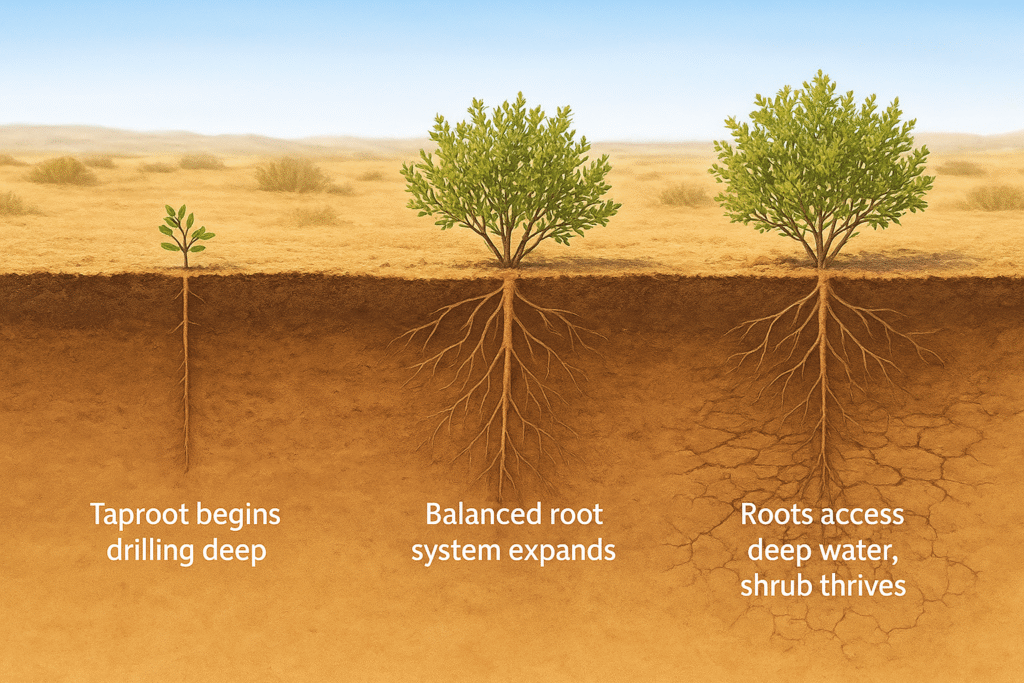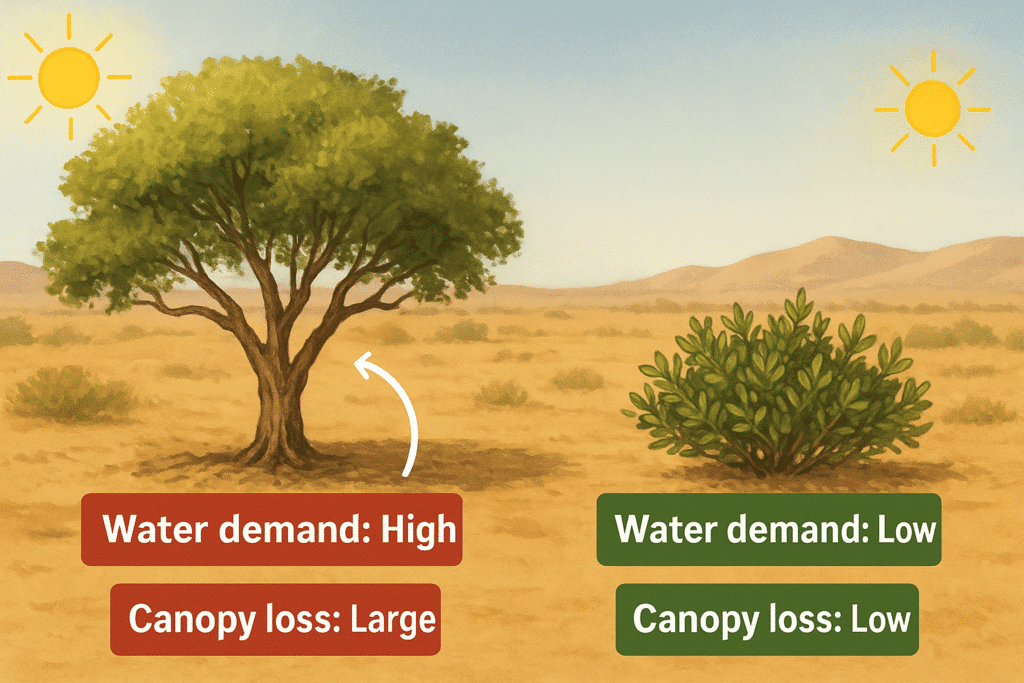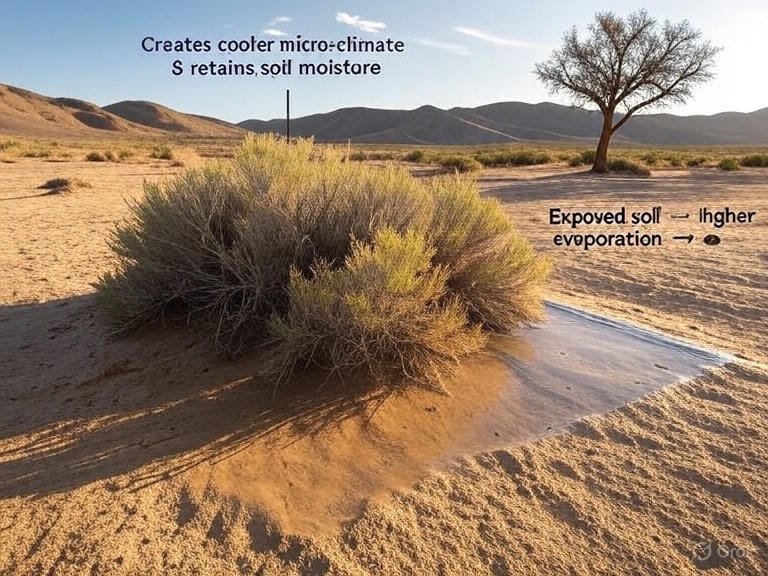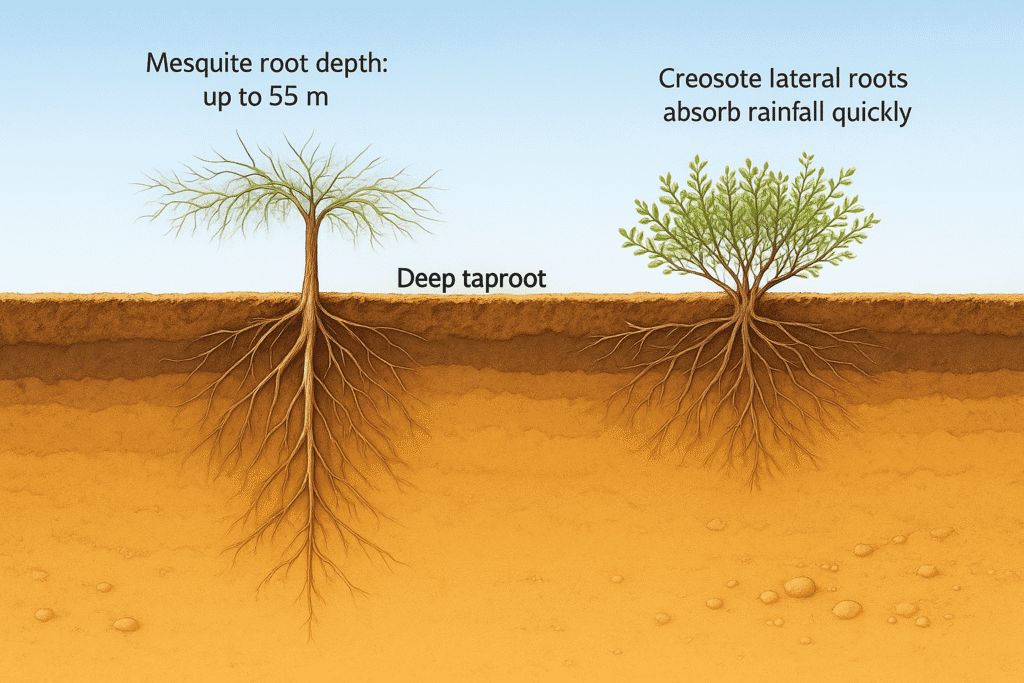
Table of Contents
ToggleSurvival puzzle of shrubs
Do you know why deserts are the most harsh environment on earth ? Because blistering heat, scarce rainfall, and nutrient-poor soil make survival incredibly difficult. Yet in such forgiving landscapes, a surprising pattern emerges – shrubs often outlive/defeat trees in terms of survival. Even though trees appear stronger and deeper rooted. But the question is, why do shrubs survive better than Trees in Deserts?
The answer lies in a mix of evolutionary design and scientific adaptation. Shrubs typically maintain smaller canopies that allow them to lose far less water by evaporation as compared to tall desert trees. Sometimes their root systems are less extensive in diameter than trees but it is remarkably efficient at channelling water from deeper underground.
But the survival of shrubs isn’t just a botanical curiosity- it carries powerful implications for the future. As water scarcity intensifies worldwide, scientists are studying desert plants to inspire solutions for sustainable agriculture, drought-proof landscaping, and even urban greening. We may find nature’s blueprint for survival in a hotter & drier world by unlocking the secrets of shrubs. There is also a lot of impact of desert planting.
Why shrubs Survive better than Trees in Deserts
At first glance, trees appear to be the champions of survival. They are taller, sturdier and often grow deeper roots than shrubs. Yet, in the desert the story is weird because shrubs are the real survivors. To understand this mystery we must look closely :-
1. Smaller canopies, less water loss
Trees carry wide crowns of leaves that demand large amounts of water for photosynthesis. In the desert, tree canopies become a liability. On the other hand, shrubs keep their leaf area small, which reduces surface evaporation. Many desert shrubs, like creosote bush (Larrea tridentata) or sagebrush, have leaves coated with wax layers that reduce transpiration. Shrubs create a sustainable balance with their environment by simply demanding less waterfall day.
2. Efficient Root systems: deep and adoptive
Shrubs often balance dual strategies –
- Taproots that extend deep into underground aquifers.
- Fibrous lateral roots that capture sudden rainfall near the surface
Trees like mesquite may drill roots down more than 50m, but they heavily rely on constant deep groundwater. Yet shrubs manage flexible survival. When surface rains arrive their lateral roots absorb it immediately and when drought hits their deep taproots keep them alive. This dual-nature adaptability gives shrubs an advantage in unpredictable desert climates.
3. Lower Energy Demand
Trees invest their energy into growing tall trunks and branches to compete for sunlight. In desert sun is abundant so this is unnecessary. Shrubs remain low & compact and avoid wastage of energy. Less structural biomass means less maintenance and less water demand for circulation. Water demand is a big reason why tree planting in deserts fails.
4. Specialised physiological adaptations
Shrubs are equipped with unique features, and these tactics allow shrubs to never overspend water – unlike trees, which must keep sap flowing to sustain their large body mass.
- Dormancy ability: Some shrubs can slow their metabolism and pause growth during extreme drought. Trees rarely have this flexibility.
- Stomatal control: Shrubs open stomata only during cooler hours (dawn or dusk) to reduce evaporation.
- Leaf shedding: certain desert shrubs drop their leaves entirely during drought and they survive as woody skeletons until the rain returns.

5. Longevity Through Minimalism
Paradoxically shrubs stay smaller and that’s why they live longer. Creosote bushes in the Mojave Desert are estimated to be nearly 12000 years old. They outlive almost every tree species in the region. Their survival secret lies in avoiding excess of growth, water consumption and maximising resilience.
6. Competition Advantage
Trees often require rich soils and consistent moisture to thrive. So in desert they compete poorly. However slubs tolerate poor, salty and sandy soils. Their nutrient efficiency allows them to dominate harsh terrains where trees either die or are never established.
7. Role in the Ecosystem
Shrubs are not just survivors they stabilize desert ecosystems. They reduce soil temperature and help in moisture retention by providing shade at ground level. Their roots anchor sand, preventing erosion, and their berries, seeds & flowers sustain desert wildlife. In contrast, Trees demand more resources and offer fewer ecosystem benefits in arid lands.
8. Modern Implications : What we can learn
The survival strategies of shrubs are inspiring new approaches in agriculture and urban planning. Scientists are experimenting with shrub-based crops for arid zones because they require less irrigation. Landscape designers also prefer drought-tolerant shrubs for sustainable cities. If global warming continues to increase heredity then the future of desert survival may look more like shrubs than trees.
Deep Root systems of desert plants
The survival of desert vegetation is written in the hidden world of roots, underground. Surface looks barren and lifeless and hence what happens beneath the soil determines which species will thrive. Shrubs and trees both rely on roots for water, but their strategies are different.
Trees like the mesquite (Prosopis juliflora) are famous for developing extraordinary deep taproots that can reach more than 50m and tap ancient groundwater reserves. This makes them impressive survivors when aquifers are available, but it also makes them dependent. If the deep water disappears, the tree is doomed. However, shrubs balance both depth and flexibility, and that’s why shrubs survive better than Trees in Deserts.
Plants such as the creosote bush (Larrea tridentata) combine a moderately deep taproot with sprawling lateral roots near the surface. This dual system allows them to capture sudden rainfall instantly and still get underground reserves during drought. According to research by the U.S. Department of Agriculture (USDA), some desert shrubs develop roots over 5 meters deep.
Such root architecture isn’t random; it’s an evolutionary design that is tuned to desert rhythms. When flash floods occur, lateral roots absorb moisture before it evaporates. When long dry spells return then taproots secure stability. This adaptability gives shrubs a clear advantage over trees whose single deep-root system may be powerful but less versatile.
Beyond survival, these deep root systems also shape Ecosystems. They prevent soil erosion, redistribute scarce nutrients and even support microbial life that helps the desert soil to remain fertile. Shrubs have mastered the art of engineering roots for resilience, and in many ways, these roots are the true lifeline of the desert. This is the reason why shrubs survive better than Trees in Deserts.

Water efficient shrubs vs trees
In desert every drop of water is counted and ability to use it wisely decides which plant will exists. Shrubs and trees have different methods to manage water, not just in size but also in physiology. Shrubs are masters of efficiency. Their leaves are often small, thick, and covered with a coating or tiny hairs. All these help them to limit water loss by reducing surface evaporation.
Many shrubs also employ stomatal control. They open their leaf pores only during cooler hours such as early morning or Dusk. This minimizes transpiration when heat is highest. In contrast, trees with large canopies expose more leaf area to sunlight which results in far greater water loss throughout the day.
Another unique adaptation of shrubs is their ability to switch photosynthetic strategies. Some desert shrubs use CAM photosynthesis in which carbon dioxide is absorbed at night instead of during the day. This significantly reduces water use. On the other hand, Most desert trees stick to traditional photosynthesis that demands higher water intake.
Moreover trees symbolise strength and shrubs embody resilience. By optimising photosynthesis, controlling stomata and evolving specialized leaf structures shrubs can thrive on minimal resources which makes them overall the true champions of desert water management.
Native desert plant root depth Comparison
Native Desert Plant Root Depth Comparison
| Plant | Type | Typical Depth | Max Depth | Spread | Notes |
|---|---|---|---|---|---|
| Mesquite Prosopis spp. | Tree | 10–25 m | ~50+ m | Moderate | Deep taproot, stable groundwater. |
| Creosote Bush Larrea tridentata | Shrub | 2–5 m | ~6–7 m | High | Dual system: rain capture + drought survival. |
| Sagebrush Artemisia tridentata | Shrub | 1.5–3 m | ~4–5 m | High | Shallow moisture uptake, drought-deciduous. |
| Palo Verde Parkinsonia spp. | Tree | 5–12 m | ~15–18 m | Moderate | Green stems photosynthesize, drought-tolerant. |
| Tamarisk / Tamarix spp. | Shrub/Tree | 5–12 m | ~20+ m | Moderate–High | Salt-tolerant, invasive in riparian deserts. |

FAQs
Why shrubs Survive better than Trees in Deserts despite their shallow roots ?
Why shrubs survive better than Trees in Deserts has a simple answer : Their desert plant root depth is complemented by lateral spread, which means they can soak up short bursts of rainfall before it evaporates. Trees depend on deep water sources which may not always be reliable in shifting climates. Shrubs also lose less water through smaller canopies and highly efficient leaves.
What is the typical desert plant root depth and why does it matter?
The typical desert plant root depth varies widely. Shrubs usually reach 2-5 meters while desert trees like mesquite can go as deep as 50 meters. This difference matters because shrubs balance between moderate and wide lateral spread which allows them to capture rainfall quickly. In contrast, trees depend heavily on groundwater access. It gives them an extra reason why shrubs survive better than Trees in Deserts.
Which desert plants have the deepest root systems?
The mesquite tree is famous for having the deepest recorded desert plant root depth — nearly 53 meters underground. On the other hand creosote bushes, sagebrush, and desert shrubs don’t go that deep but spread horizontally. Their adaptability is their original power.
